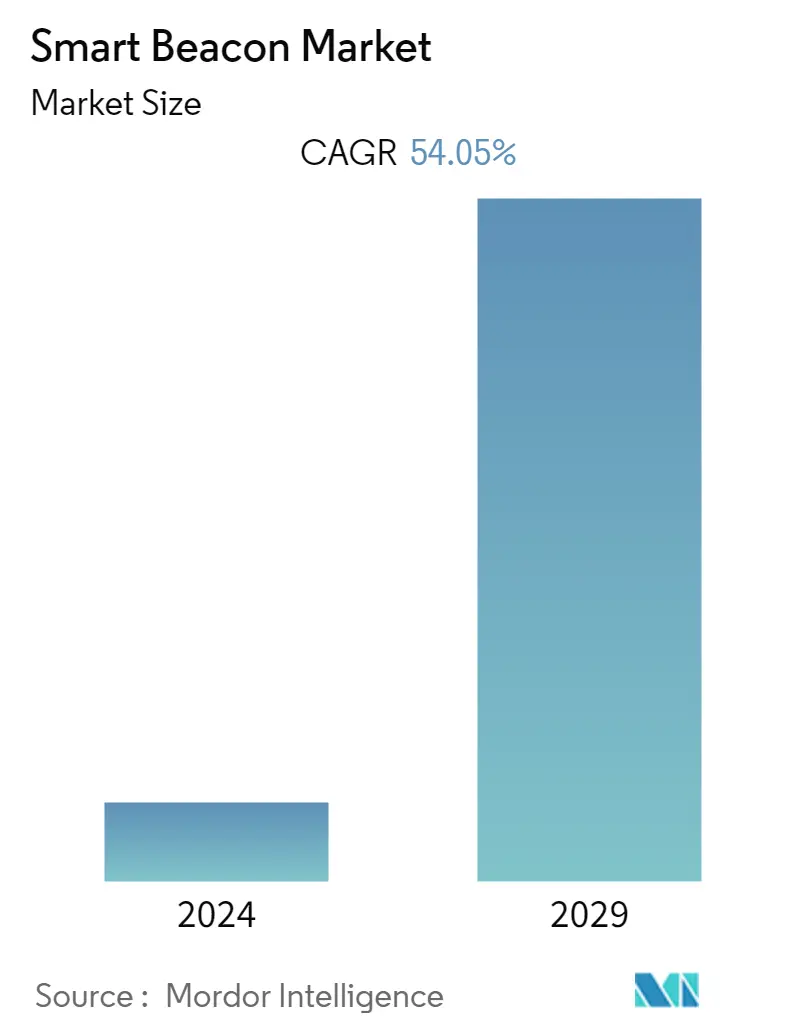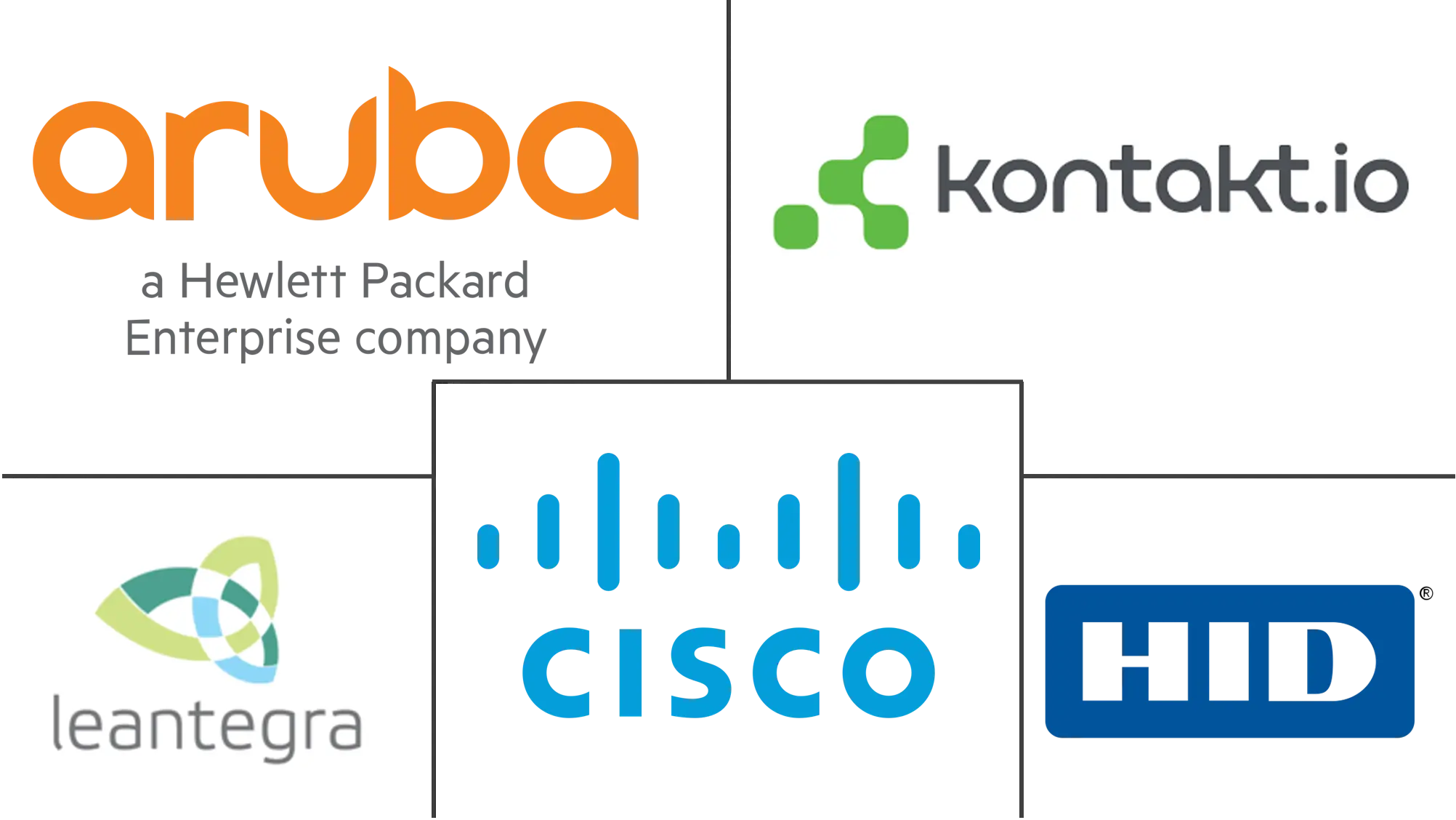| Study Period | 2019 - 2029 |
| Base Year For Estimation | 2023 |
| Forecast Data Period | 2024 - 2029 |
| CAGR | 54.05 % |
| Fastest Growing Market | Asia Pacific |
| Largest Market | North America |
| Market Concentration | Low |
Major Players*Disclaimer: Major Players sorted in no particular order |
Smart Beacon Market Analysis
The smart beacon market is expected to register a CAGR of 54.05 % during the forecast period. Beacon technology enables smartphones, tablets, and other devices to perform actions close to a beacon. Because of characteristics such as the increased probability of successful sales, improved customer relationships, enhanced tailored experience, and real-time & affordable nature when compared to traditional marketing, proximity marketing has seen increased investment. Furthermore, increased mobile penetration promotes the expansion of proximity marketing.
- The increasing need for spatial data, which can be used to analyze the current demographic trend, is driving the growth of the market studied in various applications. One of the most widespread usages of beacon technology in higher education is the expedition of administrative tasks, such as attendance monitoring. Attendance monitoring via beacons increases efficiency and saves time. It also replaces a physical attendance sheet with spatially and automatically detected attendance information.
- Increasing globalization and demand from the automobile sector will emerge as key market development drivers. Increasing emphasis on business intelligence to achieve a competitive edge, increased usage of spatial data in analytics, rising demand for smart beacons for indoor navigation, and expanding industrialization would contribute to the market's growth.
- Moreover, by creating virtual perimeters around real-world geographic areas to communicate with users in those areas, players are focused on innovating advanced geofence technology and spatial data for increasing the audience reach and capturing telematics around hundreds of thousands of points of interest in the smart connect platform.
- The lack of information and technological skills will hamper the market's expansion. Technical obstacles, interoperability concerns, and bluetooth low energy technology's restricted sensing capabilities may slow the market's development pace even more. Large-scale technology restrictions in developing nations, and increased security and privacy concerns, may further challenge market expansion.
- During the COVID-19 Pandemic, the market is hampered due to the closure of many retail stores and the close of various end-user industries. Post-pandemic, the market is growing rapidly with the reopening of stores and resuming of various end user activities. With the increased mobile penetration, the market is propelling further.
Smart Beacon Industry Segmentation
Beacons are small, wireless transmitters that use low-energy Bluetooth technology to send signals to other nearby smart devices. With its offerings as a service, hardware and software, the market focuses on various end-user applications, such as retail, sports, transportation, and logistics.
The Smart Beacon Market is segmented by Standard Type (iBeacon, Eddystone), by Connectivity (Bluetooth Low Energy, Wi-Fi), by End -Users (Retail, Sports, Transportation and Logistics, Construction, Aviation, Healthcare, and Automotive), and by Geography (North America (United States, Canada), Europe (Germany, United Kingdom, France, Rest of Europe), Asia Pacific (China, Japan, Australia, South Korea, Rest of Asia Pacific), Rest of the World).
The market sizes and forecasts are provided in terms of value in USD for all the above segments.
| iBeacon |
| Eddystone |
| Other Standard Types |
| Bluetooth Low Energy |
| Wi-Fi |
| Other Connectivity |
| Retail |
| Sports |
| Transportation and Logistics |
| Construction |
| Aviation |
| Healthcare |
| Automotive |
| Other End-Users |
| North America | United States |
| Canada | |
| Europe | Germany |
| United Kingdom | |
| France | |
| Rest of Europe | |
| Asia Pacific | China |
| Japan | |
| Australia | |
| South Korea | |
| Rest of Asia Pacific | |
| Rest of the World |
Smart Beacon Market Size Summary
The smart beacon market is experiencing rapid growth, driven by the increasing adoption of proximity marketing solutions that leverage beacon technology. This technology enables devices like smartphones and tablets to interact with beacons, facilitating enhanced customer engagement through tailored experiences and real-time interactions. The market's expansion is fueled by the growing need for spatial data across various sectors, including retail and education, where beacons are used to streamline processes such as attendance monitoring. The automotive sector and the rise of indoor navigation further contribute to market growth, as businesses seek to gain a competitive edge through advanced business intelligence and analytics. Despite challenges such as technical limitations and privacy concerns, the market is poised for significant development, particularly in regions like Asia Pacific, where organized retailing is on the rise.
In the retail sector, smart beacons are revolutionizing the shopping experience by providing location-based marketing solutions that enhance customer interactions and drive sales. Retailers utilize beacon technology to offer personalized promotions and improve store navigation, thereby increasing operational efficiency and customer satisfaction. The proliferation of retail stores globally, especially in regions like India, is boosting the demand for smart beacons. Additionally, the technology's application in venues such as stadiums and malls highlights its versatility in generating new revenue streams through proximity-based marketing. The market is characterized by fragmentation, with key players like Aruba Networks, HID Global, and Cisco Systems actively engaging in strategic partnerships and innovations to maintain a competitive advantage. Recent developments, such as the deployment of BLE beacons by HID Global in Belgium and the introduction of advanced tracking technologies by infsoft, underscore the ongoing advancements and potential of the smart beacon market.
Smart Beacon Market Size - Table of Contents
1. MARKET SEGMENTATION
-
1.1 By Standard Type
- 1.1.1 iBeacon
- 1.1.2 Eddystone
- 1.1.3 Other Standard Types
-
1.2 By Connectivity
- 1.2.1 Bluetooth Low Energy
- 1.2.2 Wi-Fi
- 1.2.3 Other Connectivity
-
1.3 By End-User
- 1.3.1 Retail
- 1.3.2 Sports
- 1.3.3 Transportation and Logistics
- 1.3.4 Construction
- 1.3.5 Aviation
- 1.3.6 Healthcare
- 1.3.7 Automotive
- 1.3.8 Other End-Users
-
1.4 By Geography
- 1.4.1 North America
- 1.4.1.1 United States
- 1.4.1.2 Canada
- 1.4.2 Europe
- 1.4.2.1 Germany
- 1.4.2.2 United Kingdom
- 1.4.2.3 France
- 1.4.2.4 Rest of Europe
- 1.4.3 Asia Pacific
- 1.4.3.1 China
- 1.4.3.2 Japan
- 1.4.3.3 Australia
- 1.4.3.4 South Korea
- 1.4.3.5 Rest of Asia Pacific
- 1.4.4 Rest of the World
Smart Beacon Market Research FAQs
What is the current Smart Beacon Market size?
The Smart Beacon Market is projected to register a CAGR of 54.05% during the forecast period (2025-2030)
Who are the key players in Smart Beacon Market?
Aruba Networks (Hewlett Packard Enterprise Development LP), HID Global Corporation, Leantegra Inc., Cisco Systems, Inc. and Kontakt.io Inc. are the major companies operating in the Smart Beacon Market.




